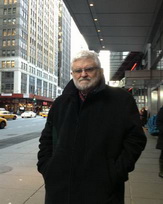It
was in March, 1946, that the phrase “Iron Curtain” came into common currency
when it was used by Churchill in his speech at
Westminster
College
in
Fulton
,
Missouri
.
“From
Stetin in the Baltic to
Trieste
in the
Adriatic
an "Iron
Curtain" has descended across the continent.”
With the Second World War
only concluded months before, a new period of tension was becoming a reality. In
the years that followed, described with the chilling phrase of the ‘Cold
War’, East faced West in a stand-off given the acronym MAD- Mutually Assured
Destruction. It was a time of brinkmanship, a time of spy rings infiltrating
both sides at the highest level and years of ever-growing arsenals of nuclear
weapons.
Into that scenario came the
peace movements, groups of individuals who came together to protest the arms
race. Many of their number paid the price of their stand in the courtrooms of
Europe and the
United States
.
With the collapse of this
division some forty years after the speech in
Fulton
, the politics of the Western world
were dramatically transformed. The influence of John Paul II is said to have
been significant in hastening the changes that occurred. The courage and realism
showed by Mikhail Gorbachev, the last leader of the
USSR
, must also be recognised.
That was in 1989. Now, a
quarter of a century later, we are again facing risks that we thought were part
of history.
It is within this context
that the Church in
Europe
is facing a huge challenge. With
falling congregations and a drastic fall in vocations to the priesthood, a
continent framed in the spirit of Christian faith over many hundreds of years is
rapidly changing. How does the Church proclaim the message of Christ in what is
at best an indifferent culture and at worst one that is openly hostile to the
faith that we profess?
In a blog posting in last
week’s Tablet where I compared the home family with the larger parish family I
wrote this:
“We
leave our homes on many journeys, returning later for rest, relaxation, security
and recreation. Our identity is recognizable in the artefacts, the furnishing,
the family pictures and the ornaments. It is from within our homes, situated
within a geographical parish, that our early lives are formed and attitudes
tested within the safety of the family.
The
Church is that family writ large, for our experiences at home, the joys and the
tensions, the sorrows and the pains, are reflected within broader communities,
be they the local parish, the diocese or the national Church.”
The
full posting can be found at http://www.thetablet.co.uk/blogs/1/575/0/our-evangelisation-plans-rest-on-outdated-assumptions
We
must recognise the very real and fundamental change in Western society, at so
many levels, if we are to successfully make our Christian message relevant to
those we live with and work among.
Maybe
we could start with remembering that phrase from the early Church ,
“See how these Christians love one another”
END
----------

